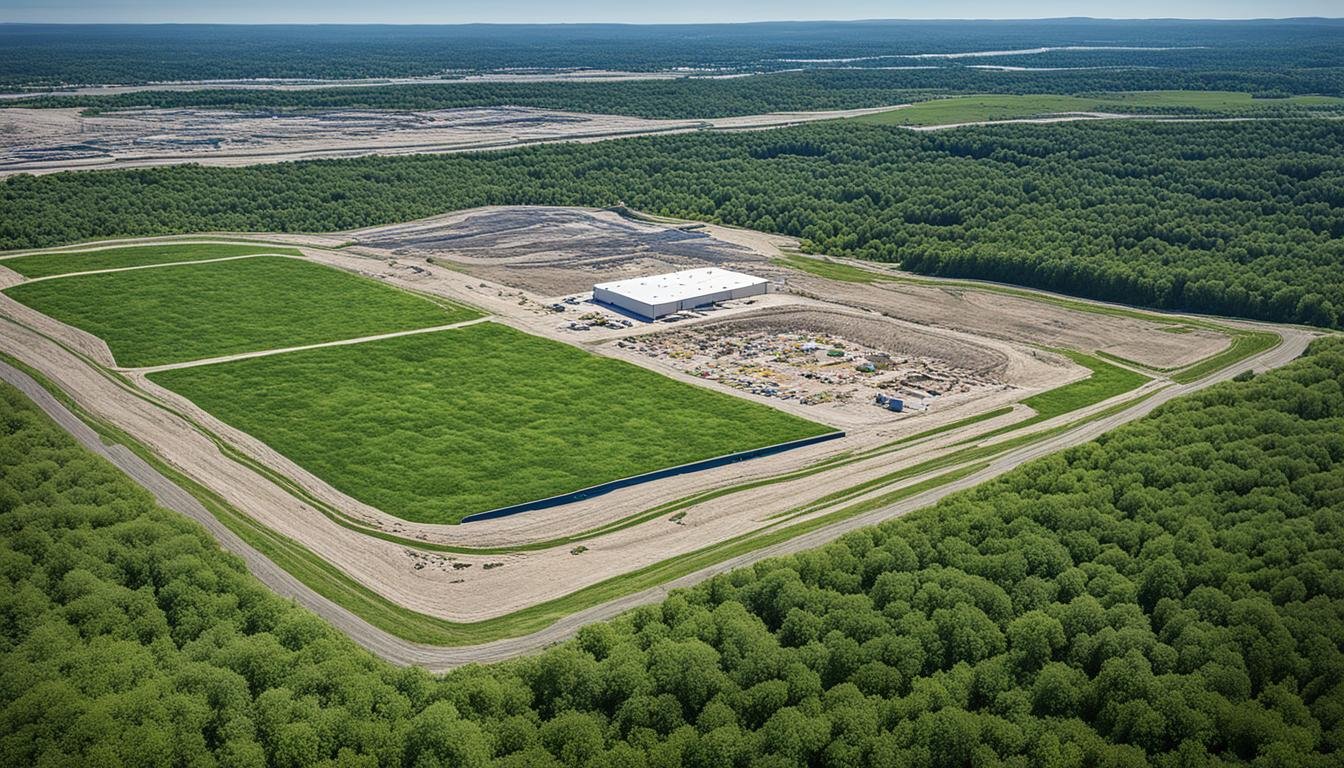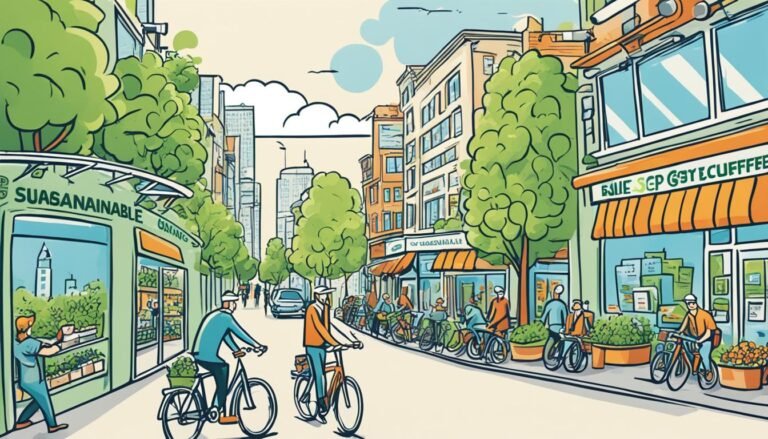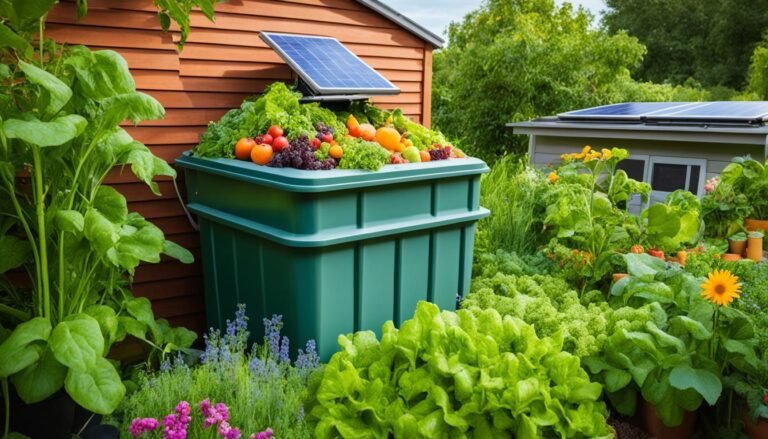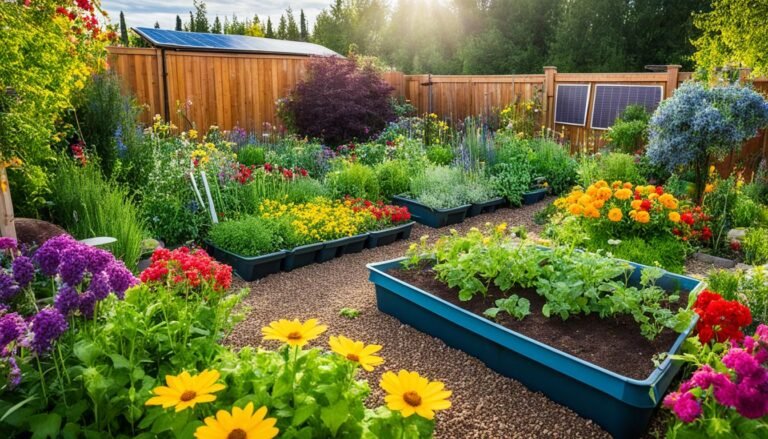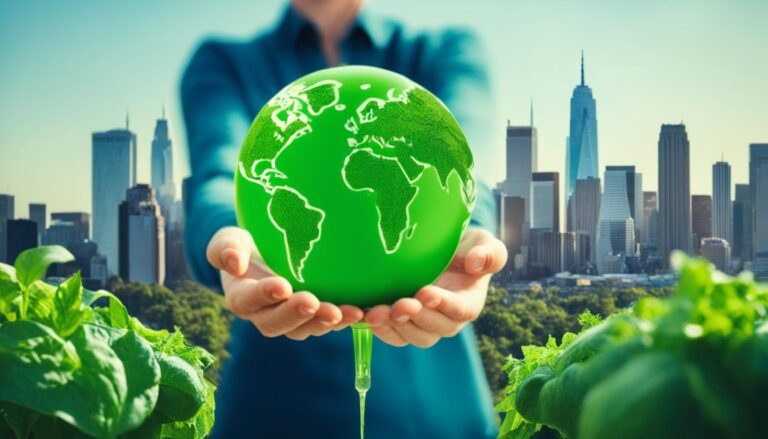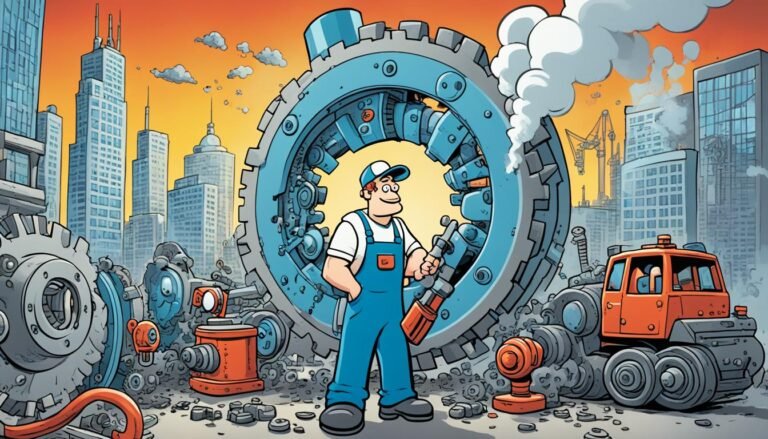From Landfill to Landscape: Restoring Ecosystems and Protecting Biodiversity
In today’s world, being green is key. Turning trash heaps into beautiful landscapes is a big deal. It helps nature heal and makes our cities better places to live. For instance, the Puente Hills Regional Park in LA turned a 142-acre dump into green space with a $12.5 million grant.
California’s Governor Gavin Newsom has a big goal: save 30% of the state’s lands and seas by 2030. This highlights the importance of such projects. Getting $1 million to plan more parks, or $5.55 million to save open spaces, shows we’re serious about caring for our planet.
Across the globe, places like Hong Kong, Northern Italy, and the UK prove landfill restoration works. We’ve seen more plants and animals, with up to 44 animal species in one spot. This includes lots of bugs in the meadows that are now covered in flowers.
Landfill projects are more than just fixing waste issues. They help the planet by boosting animal and plant life, and giving us more green areas. Reusing old dumps this way is vital today. It helps fight climate change, protects wildlife, and makes people’s lives better.
Key Takeaways
- Nearly $120 million in grants were awarded to 43 habitat conservation and restoration projects.
- The Puente Hills Regional Park project received a $12.5 million grant to transform 142 acres of landfill into a regional park.
- Governor Newsom’s 30×30 initiative aims to conserve 30% of California’s lands and coastal waters by 2030.
- Studies in Hong Kong and Northern Italy demonstrate successful biodiversity restoration on reclaimed landfill sites.
- Waste management initiatives are critical for enhancing biodiversity and ecological resilience.
The Importance of Ecosystem Restoration
Ecosystem restoration aims to bring life back to damaged areas. It works on about a quarter of our planet’s land that is hurting. This harm affects 1.5 billion people and costs up to $10.6 trillion a year.
The Role of Environmental Remediation
Environmental remediation is vital for recovering polluted areas. It focuses on cleaning up and safely getting rid of harmful waste. This helps habitats grow again, ensuring many plants and animals can live and thrive.
Benefits to Biodiversity Conservation
Restoring ecosystems helps protect our planet’s living diversity, or biodiversity. Since 1970, the number of wild animals has declined by 60%. By fixing their homes, we give endangered animals a chance to survive. Rewilding places in Europe also shows how diverse settings support a wide variety of life.
Climate Change Mitigation
Restoring ecosystems is key to fighting climate change. Healthy lands can store carbon and keep the climate stable. By 2030, we must cut greenhouse gas emissions by almost half to avoid bad climate problems. Restoring the Earth helps us reach this important goal.
Case Studies: Successful Landfill Transformations
More and more, people are turning to landfill reclamation to solve environmental issues and make new green areas. This method has changed empty areas into thriving spaces across the globe. It shows us the power of using landfills differently.
Nearly 33% of the research articles on landfill transformations focused on the field water balance in final covers, underscoring the importance of efficient water management strategies in rejuvenating these areas.
The Freshkills Park stands on what used to be a landfill in New York City. This project is a great example of making green spaces out of old landfills. It not only brings nature back but also helps refresh the city. Other sites, like old closed landfills, saw 9% of studies focusing on how plants were growing there. This shows us how landfills can be reused in creative ways.
Studies show that 17% looked at how plant roots are important for the ground’s strength. This keeps the new green areas strong and lasting. Also, 15% talked about putting solar panels on closed landfills. This is another smart way to use these spaces again.
Bringing life back to areas once used by industry is another big benefit. 29% of studies talked about this. They showed how it makes cities more beautiful and gives homes to wildlife.
Some projects, like planting trees for ten years in certain landfills, kept showing good results. These actions help the environment and bring neighbors together. It’s about creating a better future for everyone.
In the end, 75% of the research focused on how important plants are for these new areas. This proves that landfill reclamation works. It’s not just about fixing the land. It’s about building better places for people and nature to live together.
The Puente Hills Regional Park Initiative
The Puente Hills Regional Park initiative is a huge step for Los Angeles County’s park development. It aims for big changes in both the environment and how people get involved. This project will turn a big space, once a major landfill, into a new park. This is the first time the county has done this kind of project in over 30 years.
A Historical Overview
For nearly 60 years, the Puente Hills Landfill collected about 150 million tons of trash. But before it was a dump, it was a mix of different natural areas. These included oak-woodlands, coastal sage scrubs, and chaparral.
The change aims to bring back these natural parts. The Wildlife Conservation Board of California has put nearly $120 million towards 43 projects to help nature. About $12.5 million of that is for the Puente Hills Regional Park. This work is part of a bigger goal to protect 30% of California’s lands by 2030.
Community Involvement and Engagement
Engaging the local community is key to the success of this project. People who live nearby are part of the planning and choices for the new park. They want it to be a place that helps nature and heals the community. This shared work looks to the future where nature and people live well together.
Ecological Impact and Future Prospects
This park’s change will make a big difference for the environment. It will help fix problems like loss of natural areas and the break-up of living spaces for animals and plants. Once native plants are back, Puente Hills Regional Park will be beautiful. It will share native scenes with millions in LA and beyond.
There’s a lot to look forward to with this park. The project is part of a bigger effort to protect lots of lands in California. Together, these efforts are saving about 28,000 acres. This project is a good example of how to fix big environmental problems. It’s a path for more developments in parks and nature conservation.
Saw Mill Creek’s Wetland Mitigation Success
Saw Mill Creek in Staten Island is a shining example of a successful wetland mitigation bank. It offers key lessons on how to tackle ecological problems and boost local wildlife. The project is renowned for its new ways to restore habitats and its big wins for nature.
Project Overview
The Saw Mill Creek project started to replace lost wetlands. It mainly works on bringing back estuarine and freshwater wetlands. This part of a big plan to make a strong wetland mitigation bank. It blends natural processes with help from people in the community. This method made sure everything met the rules, brought environmental bonuses, and helped the economy too.
Challenges in Restoration
Restoring places like Saw Mill Creek faces tough jobs. Cutting out invasive plants and making native ones grow was hard. Fonseca’s work in 1989 shows that often, we need to keep trying and adapting to manage these places well. Getting water and its quality just right was also key for getting the ecosystem working again.
Impact on Local Biodiversity
The work at Saw Mill Creek had a big impact on the all the creatures and plants. By improving and stabilizing habitats, it helped local wildlife grow. Studies like Harris in 1988 show how important making the right environment is. The project, like works at the Salmon River Salt Marshes by Frenkel and Morlan in 1990, boosted the number of species here, making it a great home for many.
Shirley Chisolm State Park: A Transformative Project
Shirley Chisholm State Park is a project that shows how a new idea can change a landfill into a valuable urban green space. It covers 407 acres, marking a big win for landfill repurposing and nature restoration. This space used to be the Fountain Avenue and Pennsylvania Avenue landfills.
From 1956 to 1985, these landfills gathered lots of trash and dangerous waste each year. But in 2004, the recovery work truly began. They put down a huge plastic sheet, added a layer for drainage, and covered it with soil. This was the start of turning this area into a park. Experts planted 40,000 trees, like pine, oak, and willow, showing nature’s comeback.
In 2019, the park opened for everyone. It’s not just for the environment; it has things like benches, tables, and trails for fun. Also, pipes under the ground control gas from the old trash, making two flare stations necessary. This pretty, green space is important for both looks and keeping the air clean.
Many locals pushed to make this place better. They started with marches to show everyone the dangers. Their efforts led to big changes over two decades, making the park what it is today. They built walkways and spots to look out over the land. Flowers and grass soon followed, bringing back birds like ospreys, egrets, and snowy owls.
In 2017, the park became part of the State’s efforts for recreation and history. Now, it’s a big part of New York City’s natural spot. Shirley Chisholm State Park’s success is a great example. It proves how city parks can lead by transforming old areas into new havens for people and nature.
Adopting Best Practices in Habitat Restoration
Habitat restoration helps fight climate change and saves plant and animal species. The world aims to stop destroying ecosystems by 2030, as part of the Sustainable Development Goals. Following the right steps in restoring habitats can heal the earth and keep it in balance.
Community Participation
Getting the local community involved is key to making habitat restoration work. This ensures the project meets local needs and values. It’s also important to help groups that might be left out, like native peoples and women.
Educating young people about restoring land turns them into nature’s friends. Plus, it teaches them skills they can use for jobs that help the earth over the long term.
Use of Native Plants
Using species that are local to the area is crucial in restoring habitats. These plants are used to the environment and need less care. This way, they help create a better home for animals and make sure nature stays in balance.
Choosing natives over other plants also cuts down the risk of invasive species. These invaders can harm local plants and animals, disrupting the natural order.
Sustainability and Long-Term Maintenance
Projects must be sustainable to really work. Changing how we consume, making eco-friendly choices, and having green spaces at home help a lot. We need to keep an eye on restored areas and adapt as needed.
For areas near the coast, we must think about the salty soil and how it affects animals and plants. Considering these factors ensures our work lasts.
Following these practices boosts the chances of success. This includes involving the community, planting native species, and being eco-conscious. These steps help build strong ecosystems that will benefit future generations.
“Restoration efforts must be rooted in community involvement, native vegetation, and sustainable management to address the global challenge of ecosystem degradation.”
Reaching these goals needs funding and rules at the local and global levels. The Bonn Challenge has over 60 countries working together for a greener world. Together, we can achieve a lot for the planet’s health.
From Landfill to Landscape: Restoring Ecosystems and Protecting Biodiversity
The change from landfill to landscape shows how much we can do to protect our environment. The Saw Mill Creek and Shirley Chisholm State Park projects in NYC are great examples. They’ve made the water and ground cleaner while giving more animals and plants a home.
WSP works with local groups to turn trash areas into new, green spaces. For instance, at Saw Mill Creek, they cleaned up the area by removing contaminated soil and trash. This made the place better for plants and animals. More than 40,000 cubic yards of bad soil and 40 truckloads of trash were cleared from the 54-acre site.
Thanks to this, the plants and animals in these areas are doing really well. It’s almost like these places have always been safe and clean for them.
In the UK, old landfill sites have become great places to study nature. They found that these fixed-up spots actually have more types of plants and animals. These findings show how important fixed-up lands are for our environment.
In the Czech Republic, they’ve been keeping an eye on plants in these areas since 2008. They’ve found nearly 300 different plant types. This shows that these areas are doing a lot to help nature grow back.
Some places, like Shirley Chisholm State Park, are using creative ways to build their new landscapes. They use things like geofoam, glass, and special mats to help grow nature back. They’ve also turned old shipping containers into places where you can learn about nature and history.
These projects are not only cleaning up old dump sites. They are creating homes for lots of plants and animals. This shows how much we can achieve when we work together to protect our planet.
Future Trends in Ecological Sustainability
In the future, we’ll see a lot more interest in ecological innovations and sustainability trends. This growing focus will change how we care for nature and build green infrastructure. New ecological innovations will reshape how we heal ecosystems and protect diverse life.
Big players like SWCA, RECON, and Tetra Tech are already making waves. They use advanced methods in Soil Pollution Remediation and more. The field is getting bigger, with the market for Environmental Restoration and Conservation expecting to reach millions by 2029. This growth will be steady from 2023 to 2029.
“Ecosystem restoration is a significant challenge that requires urgent action to protect nature for future generations.”
Driving this growth are more people, better tech, government support, and a greater sense of ecological advantages. Places like North America, Europe, and Asia Pacific will invest a lot in ecological products. China is becoming a key player, attracting a lot of interest from investors and experts.
Areas like Mines, Landfills, and fighting Groundwater Pollution are shining because of these new ideas. Global efforts, like the United Nations Decade on Ecosystem Restoration (2021-2030), aim to cut greenhouse gas emissions by 2030 and save biodiversity. They bring in new plant species and ecosystems, showing how far we’ve come in saving our natural world.
All over the world, both companies and communities are turning to green projects. These projects aim to make our planet healthier by blending nature into cities and keeping it up for the long haul. As more and more people learn about the benefits of natural habitat conservation, we can expect to see more clever and greener ways to care for our Earth.
Conclusion
The journey from dumpsite to beautiful greens shows how we can change the world through eco-friendly actions. Even with scary stats predicting a jump in global waste to 2.2 billion tonnes by 2025, we see a chance for a better future. The U.S.A. and Brazil are made examples by still dumping over half their trash in landfills. This shows the urgent need for smarter ways to manage our waste.
But, there’s light in projects like Rapp Road, turning waste areas into thriving nature spots. This success comes from everyone working together, from the local community to scientists. They empower and support the projects, making sure they last for a long time.
New technology in Europe for landfills shows us the big hurdles and chances we have to make a change. Places like Nanhaizi Park in China have shown us the way. They’ve changed trash areas into clean, green spaces. This highlights the importance of leaving behind a healthy planet. Our future focus must be on working together in smart, green ways. This is essential to build strong, beautiful worlds for tomorrow.
Source Links
- CDFW News | Grant Awarded to Convert Former Landfill into Los Angeles County’s First New Regional Park in Three Decades
- Landfill restoration
- Redefining Ecological Restoration
- The Importance of Ecosystem Restoration: How Corporates Can Contribute
- ENVIRONMENTAL REVIEWS AND CASE STUDIES: Unique Landfill Restoration Designs Increase Opportunities to Create Urban Open Space | Environmental Practice | Cambridge Core
- Mega-eco projects: a global assessment of large-scale ecological restoration initiatives – Socio-Ecological Practice Research
- California Allocates $12.5 Million for Landfill-to-Park Transformation
- CDFW News | Grant awarded to transform former landfill into Los Angeles County’s first regional park in three decades
- CDFW News | Grant Awarded to Convert Former Landfill into L.A. County’s First New Regional Park in Three Decades – Urbanactive
- 6 Wetlands | Restoration of Aquatic Ecosystems: Science, Technology, and Public Policy
- Find Projects
- Remediation as Neighborhood and Ecological Regeneration: Shirley Chisholm State Park – Urban Omnibus
- THE DIRT
- THE DIRT
- UN Decade on Ecosystem Restoration (2021-2030)
- Sustainable Forest Land Management to Restore Degraded Lands
- Ecological restoration: guidance from theory
- From Landfill to Landscape: The Rebirth of NY City Parks
- Brownfield sites promote biodiversity at a landscape scale
- Influence of a Municipal Solid Waste Landfill on the Surrounding Environment: Landfill Vegetation as a Potential Risk of Allergenic Pollen
- Ecological Restoration and Conservation Market Size 2024: Recent Developments and Corporate Information Through 2031
- Progress of Ecological Restoration Research Based on Bibliometric Analysis
- Landfill Impacts on the Environment—Review
- CHA – Habitat Restoration and Monitoring at the Rapp Road Landfill
- The Microclimatic Effects of Ecological Restoration in Brownfield based on Remote Sensing Monitoring: The Case Studies of Landfills in China

